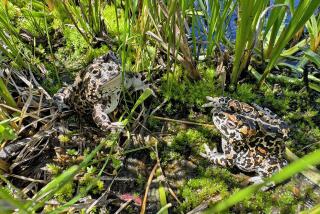Creek Is Hopping With Frogs
- Share via
Southern California’s largest population of red-legged frogs, a threatened species that has found itself in the middle of legal battles between environmentalists and homebuilders, may be living along a creek north of Santa Clarita, federal biologists said Monday.
Scientists originally estimated that 50 of the 5-inch-long amphibians were living along San Francisquito Creek in the Angeles National Forest. But after the 23,500-acre Copper Hill forest fire in June--which cleared away brush in habitats previously inaccessible to humans--biologists from the U.S. Geological Survey discovered 100 frogs there in one night.
USGS biologist Robert Fisher estimated the total population in the creek was “probably in excess of a couple of hundred.”
Environmentalists estimate that millions of red-legged frogs once populated California. The largest frogs native to the western United States, they were immortalized by Mark Twain’s 1865 short story “The Celebrated Jumping Frog of Calaveras County.”
But in recent decades, disappearing wetlands have decimated the red-legged frog population.
Fisher said the frogs along San Francisquito Creek may be the only ones of their kind in Los Angeles County, which once had thousands of them.
In Ventura County, the discovery of red-legged frogs on the site of the proposed Ahmanson Ranch housing development has been a key reason environmentalists have opposed the 3,050-home plan.
Four frogs were found there in 1999, and the U.S. Fish and Wildlife Service estimates 25 frogs live there now. The developer, Washington Mutual Bank, is planning to break ground on the project once a new study about how to protect the frog is approved by Ventura County officials.
Fisher said his team has begun working on a plan to repopulate areas such as Ahmanson Ranch’s with the newly found frogs from the Angeles forest, but their work has been complicated by a fungus in San Francisquito Creek that attacks tadpoles.
“We’re not sure if we can take the frogs from there and Johnny Appleseed them all over the place, because we could be moving the disease to other places,” Fisher said. “It’s a tenuous situation.”
The frogs face a number of other dangers in the creek. Nonnative species introduced by humans, including crawfish and goldfish, have been feasting on the tadpoles and frog eggs. And winter rains may wash debris from the forest fire into the frogs’ breeding ponds downstream. As a precaution, Fisher said, biologists are building artificial pools away from the main flow of the silt.
In 2001, the U.S. Fish and Wildlife Service designated San Francisquito Creek and 31 other California areas that may be home to the red-legged frog as “critical habitats,” a category of protected land that limits or bars development and other uses to ensure the survival of threatened or endangered species.
The designation followed a lawsuit brought by environmental groups that claimed the federal government wasn’t adhering to its own environmental guidelines.
But homebuilder groups are currently challenging the existence of 29 of those areas, including Angeles National Forest. In a federal lawsuit, they contend that the government did not properly gauge the economic impact of the critical habitats, which cover 4.1 million acres in 28 counties throughout the state.
Paul Campos, an attorney for one of the homebuilder associations that brought the lawsuit, said he did not expect the new discovery of red-legged frogs to have any bearing on the legal battle.
More to Read
Sign up for Essential California
The most important California stories and recommendations in your inbox every morning.
You may occasionally receive promotional content from the Los Angeles Times.













